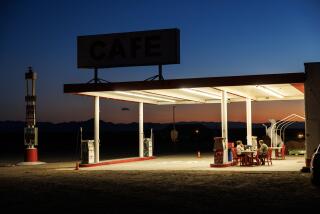Panel Green-Lights Route 66 Bill
- Share via
WASHINGTON — Congress is getting its kicks from a bill to steer motorists back to Route 66.
A House committee Wednesday approved legislation to provide $10 million for preserving historic sites along the Chicago-to-Santa Monica route that served as the main highway for Dust Bowl refugees and other Americans who went West and, in later years, families who piled into station wagons for vacations.
The bill’s supporters, including a group of Route 66 enthusiasts based in Tujunga (who don’t care that the road never went there) hope the measure will help revive interest in a road they view as an American icon.
The measure designated--what else?--HR 66 authorizes the National Park Service to award grants to public and private groups for improving and restoring historic sites along the route, such as old diners and motor courts.
Funds also might be used to produce an oral and video history of the highway (legend has it that the road was a favorite getaway route for such Depression-era mobsters as John Dillinger and Bugs Moran).
The bill, approved by the House Resources Committee on Wednesday, now goes to the House floor, where its passage is expected. A similar bill has cleared the Senate. Its chief sponsor, Sen. Pete V. Domenici (R-N.M.), touted Route 66 as the “nation’s most important thoroughfare for east-west migration in the 20th century.”
U.S. 66 was christened in 1926. At the time, parts of it were still dirt, though it became the first completely paved highway across the western United States in 1938.
Although the road--known in the Los Angeles region by such street names as Foothill and Santa Monica boulevards or Huntington Drive--was long ago rendered obsolete for long-distance travel by the interstate highway system, it is “a part of our history and a part of our literature and a part of our culture,” said Rep. Heather Wilson (R-N.M.), the bill’s chief sponsor in the House.
“The Mother Road,” John Steinbeck dubbed it in his classic novel “The Grapes of Wrath.” It was a main route for the tens of thousands of Dust Bowl refugees who migrated to California between 1935 and 1940, federal officials say.
The road was celebrated by Bobby Troup’s 1946 song, “(Get Your Kicks on) Route 66” and by the 1960s television show “Route 66.”
The California Route 66 Museum can be found in Victorville--off Route 66, naturally. Even on the World Wide Web, pages dedicated to keeping alive the memory of Route 66 can be found, including one located in Brussels.
The congressional legislation grows out of the remembrances many Americans--including members of Congress--have for the storied highway.
Rep. Wes R. Watkins (R-Okla.) recalled “nine of us” packing into a Ford to travel from Arkansas to California in 1942 so his father could find work.
“I remember stopping, and we would get the water bag filled that we would have on the front of the car so we could make it across the desert,” he said.
David Knudson, a former advertising executive who runs the 1,600-member National Historic Route 66 Federation out of his Tujunga home, joined Route 66 associations in each of the eight states through which the road runs in lobbying for the bill.
Like others, Knudson was driven by an “unforgettable” trip he took more than 30 years ago on Route 66 from Michigan to California in his Triumph two-seater. He began lobbying for preservation legislation after returning to Michigan a few years ago and trying to take Route 66 back to California.
“When we got to Chicago, and started looking for it, we couldn’t find it,” he said.
A lot of maps no longer include the road, which was officially decommissioned in the mid-1980s. Indeed, portions of the road no longer exist.
“By the time we got back to Los Angeles, we were so upset by the fact that this American treasure, certainly the most historic road in America, was so rapidly disappearing,” he said.
Knudson said he is disappointed that the bill no longer includes a provision to provide for signs on Route 66 and on interstates directing motorists to the old road. In Southern California, however, some portions of the road are marked by signs saying “Historic Route 66.”
Supporters also view the $10-million appropriation--to be allotted over a decade--as only the beginning of their preservation crusade. For instance, congressional aides said the federal funds could be used as seed money to leverage larger amounts in private investment.
Among those interested in tapping into the funds is Robert Ervin, a former Los Angeles building inspector, who is fixing up the Goffs General Store and Restaurant on Route 66 about 50 miles west of Needles.
“Sixty-Six is coming back,” he said, but “it’s going to take a little help.”
Sen. Domenici earlier sponsored legislation funding a park service study on the impact of Route 66 on American culture. The report found:
“Not only does Route 66 underscore the importance of the automobile as a technological achievement, but, perhaps equally important to the American psyche, it symbolized unprecedented freedom and mobility for every citizen who could afford to own and operate a car.”
More to Read
Get the L.A. Times Politics newsletter
Deeply reported insights into legislation, politics and policy from Sacramento, Washington and beyond. In your inbox twice per week.
You may occasionally receive promotional content from the Los Angeles Times.











